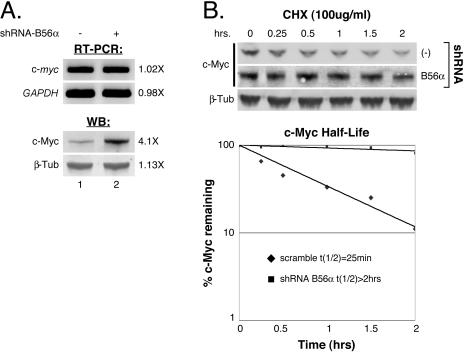FIG. 3.
PP2A-B56α regulates c-Myc protein stability. (A) Knockdown of B56α does not affect endogenous c-myc mRNA levels. HEK-293 cells were cotransfected with 50 ng CMV-βgal and 3 μg pSUPER-shRNA-empty (−) or pSUPER-shRNA-B56α under 10% FBS conditions for 24 h and then starved in 0.2% FBS for 48 h. Cells exhibiting transfection efficiencies by β-gal assay within 5% of each other were used for RT-PCR analysis of endogenous c-myc and GAPDH (glyceraldehyde-3-phosphate dehydrogenase gene) mRNA levels. Endogenous c-Myc and β-tubulin protein levels were also examined in the same experiment by Western blotting (WB) with anti-N262 and anti-β-tubulin, respectively. (B) c-Myc protein stability is increased upon B56α knockdown. One-hundred-millimeter dishes of HEK-293 cells were cotransfected with 50 ng CMV-βgal, 0.5 μg pD40-His/V5-c-Myc, and 4 μg pSUPER-empty or p-SUPER-B56α under 10% FBS conditions for 24 h. Each transfection mixture was split into six 60-mm dishes with 10% FBS and then starved in 0.2% FBS for 48 h. Cells were treated with 100 μg/ml cycloheximide (CHX), and cell lysates were prepared at the indicated time points after treatment. c-Myc and β-tubulin were visualized from samples at each time point with anti-V5 and anti-β-tubulin by Western analysis. c-Myc protein levels were quantified relative to β-tubulin levels and graphed as percent c-Myc protein remaining after cycloheximide treatment. Protein half-life was calculated using the Excel (Microsoft) graphing function.

